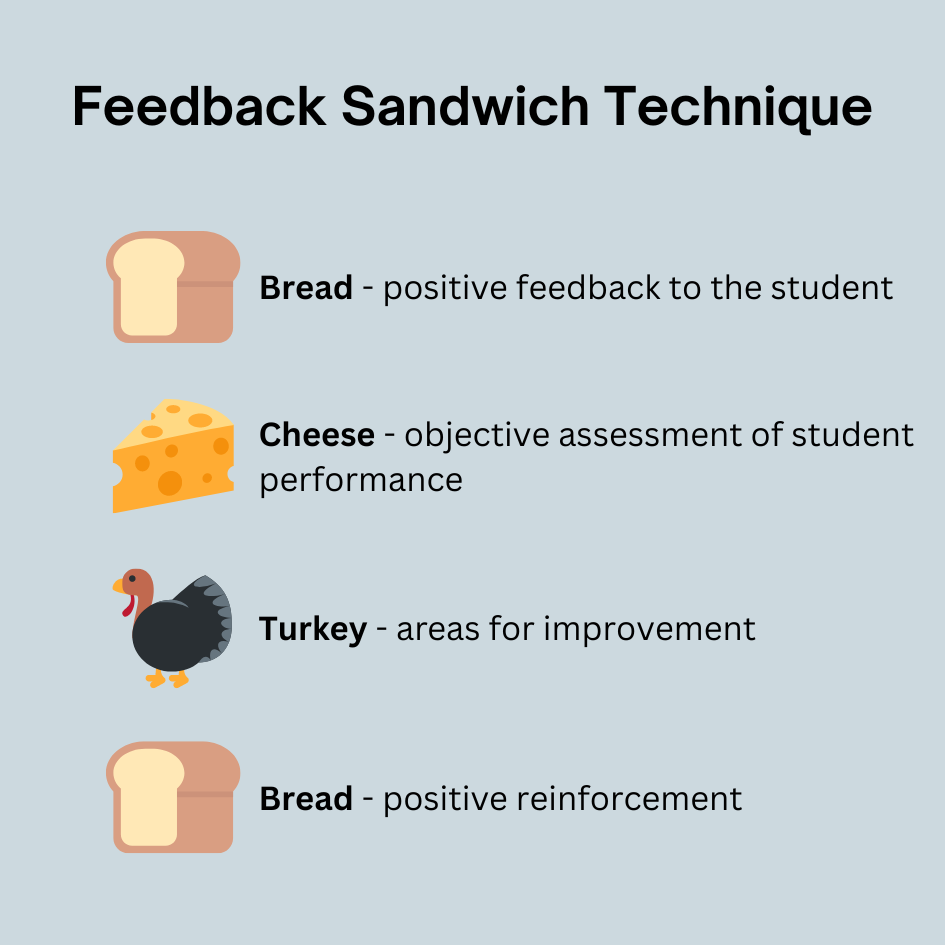The Feedback Sandwich: A Positive Approach to Giving Feedback in Nursing Education
A feedback sandwich is a teaching technique that I found exceptionally useful when providing feedback to students.
Feedback is an essential tool for the growth and development of new nurses. It helps students understand where they stand and how they can improve. However, giving feedback can be challenging, especially if it is negative or critical.
This is where the Feedback Sandwich comes in. It is a practical and positive approach to providing feedback that helps to balance criticism with praise.
What is a Feedback Sandwich?
A turkey sandwich is one of my favorite lunch foods. And the simple concept of "building a sandwich" is a helpful visual when providing feedback to a student.
By "sandwiching" negative feedback between two positive comments, you provide the student with constructive and well-rounded feedback.
This can be used in verbal or written feedback, an informal or more formal evaluation. It can be utilized at clinical as well as in the skills lab. And it is fantastic for the cumulative, overall feedback at the end-of-semester student evaluation.
How to use the Feedback Sandwich
For this example, I will imagine that I am providing feedback to a student outside a patient's room after they completed a blood draw.
🍞 Start with the bread
This is the positive information in this analogy. It could take many forms, but the idea is to provide students with information on something they are doing well.
"Way to go! You drew those three lab vials on your first try."
🥬🍅🧀 Next, the toppings, like lettuce, tomatoes, and cheese
Give the student THREE objective data points you assessed as part of your evaluation.
"You clearly explained to the patient what would happen and demonstrated your ability to provide patient education on a nursing skill. You located the vein using an appropriate technique and safely managed the sharp at the end."
🦃 After the toppings, add the protein
The turkey represents the areas of improvement for the student. You can give one or multiple ideas for improvement.
"While you verified the patient's name and date of birth, you scanned the barcode after the lab draw was collected. This should always be done before you complete the skill as a safety measure.”
🍞 After the improvements, another slice of bread
Give the student additional positive reinforcement. This could be a simple "good job!" or provide additional information about what went well.
"The patient appreciated your kindness, and the process was smooth overall."
🥪 Amazing! You created a feedback sandwich.
Here is a simple image to help you remember this technique the next time you need to provide thoughtful feedback.
Why is the Feedback Sandwich effective?
The Feedback Sandwich is effective for several reasons.
First, it helps to balance criticism with praise. This makes it easier for the person to receive negative feedback and take action on it.
Second, it provides constructive feedback that encourages growth and development. The person knows what needs to change and how they can improve.
Finally, it helps build rapport and trust between the giver and the feedback receiver. As a result, the person feels heard and valued, which makes them more likely to take action on the feedback.
Conclusion
The Feedback Sandwich is a practical and positive approach to providing feedback. It strikes a balance between praise and critique while giving constructive feedback. Nurse educators can use it in various situations, including verbal and written evaluations. So next time you need to provide feedback, try the Feedback Sandwich and see how it can make a difference for your students.
Looking for more active learning ideas?
There are many more helpful, practical articles in the Idea Bank.
Or, if you would like to incorporate active learning into your classroom, check out BreakoutRN products.

